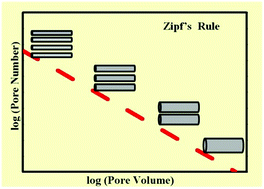The total and the differential mean pore anisotropy in porous solids and the ranking of pores according to Zipf's law
Abstract
In this work the property of total pore anisotropy in porous solids is introduced. Its calculation is based on a combination of the specific surface area Sp and the specific pore volume Vp estimated via typical nitrogen porosimetry data and tested in two kinds of porous materials: a group of spinels CoAl2O4 with differentiated random porosities and a second group of silicas SiO2 with ordered porosity modulated by the addition of LaFeO3 nanoparticles. Two basic complementary expressions of total pore anisotropy were estimated: (i) the specific total mean pore anisotropy bmean,total = (N·b) ≈ [Sp3]/[Vp2] corresponding to the total anisotropy value of all N hypothetical similar pores in one gram of a solid with mean size Dmean = 4Vp/Sp and anisotropy b = Ltotal/Dmean. The bmean,total takes a unique value for each particular porous material. (ii) The specific differential mean pore anisotropies bmean,diff = (Ni·bi) ≈ [Spi3]/[Vpi2] corresponding to the spectrum of partial anisotropy values bmean,diff = Li/Di of Ni pores with similar size Di = 4Vi/Si possessing differential pore volume Vpi and differential specific surface area Spi. The bmean diff takes different values at each particular partial pressure and exhibits a distribution as a function of pore radius bmean,diff = f(ri). It is shown that plots of log(bmean,diff) = f(log(ri)) lead to the ranking of pores according to the Zipf's law log(Ni) = A − B log(Vpi). This ranking is not obeyed by the pores exhibiting appreciable local pore anisotropy.


 Please wait while we load your content...
Please wait while we load your content...